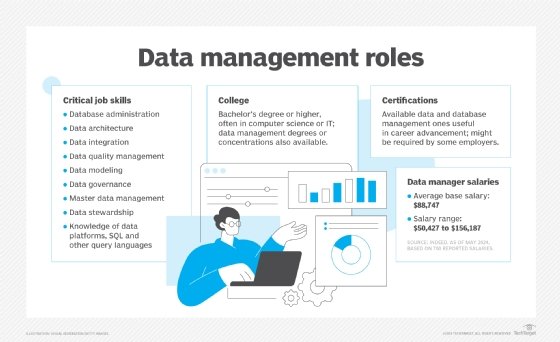Main Function of Data Management

The main function of data management is to systematically and efficiently handle the entire lifecycle of an organization's data. This encompasses a range of activities, including data collection, storage, processing, retrieval, sharing, and disposal. The overarching goal of data management is to ensure that data is accurate, secure, and available for use in decision-making, analysis, and various business processes.
Here are the key functions of Data Management:
-
Data Collection:
- Gathering data from various sources, both internal and external to the organization. This involves identifying relevant data points and capturing information in a structured format.
-
Data Storage:
- Storing data in a secure and organized manner. This includes choosing appropriate data storage technologies, establishing data repositories, and implementing data backup and recovery mechanisms.
-
Data Processing:
- Transforming and processing data to derive meaningful insights. This involves activities such as cleaning and validating data, aggregating information, and performing calculations or analyses.
-
Data Integration:
- Combining data from different sources to create a unified view. This ensures consistency and coherence in the organization's data landscape, supporting comprehensive and accurate analysis.
-
Data Retrieval:
- Enabling users to easily access and retrieve the required data. This involves creating efficient search and retrieval mechanisms, as well as implementing data query languages and interfaces.
-
Data Quality Management:
- Ensuring the accuracy, completeness, and reliability of data. This involves implementing processes for data validation, cleaning, and enrichment to maintain high data quality standards.
-
Data Security:
- Implementing measures to protect data from unauthorized access, disclosure, alteration, or destruction. This includes establishing access controls, encryption, and other security protocols.
-
Data Governance:
- Establishing policies, standards, and procedures for managing data. Data governance ensures that data is used consistently and responsibly across the organization, aligning with business goals and regulatory requirements.
-
Metadata Management:
- Managing metadata, which provides information about the characteristics, origin, usage, and relationships of data. Effective metadata management enhances data understanding and facilitates data governance.
-
Data Privacy Compliance:
- Ensuring compliance with data privacy regulations and standards. This includes implementing measures to protect sensitive information and obtaining consent for data processing when required.
-
Data Sharing and Collaboration:
- Facilitating the sharing of data among different departments and stakeholders within the organization. This promotes collaboration and supports a unified approach to data-driven decision-making.
-
Data Lifecycle Management:
- Managing the entire lifecycle of data, from creation and usage to archiving and disposal. This includes defining retention policies and implementing processes for data archival and purging.
-
Master Data Management (MDM):
- Managing core business data, such as customer information and product data, to ensure consistency and accuracy across the organization. MDM helps eliminate duplicates and discrepancies in master data.
-
Data Analysis and Business Intelligence:
- Supporting data analysis and business intelligence initiatives by providing a reliable and well-managed data foundation. This involves creating data warehouses, data marts, and implementing analytical tools.
-
Continuous Improvement:
- Iteratively improving data management processes based on feedback, changing business needs, and advancements in technology. Continuous improvement ensures that data management practices evolve with the organization.
Effective data management is crucial for organizations to derive value from their data assets, make informed decisions, and maintain a competitive edge in the modern business landscape. It involves a combination of technological solutions, policies, and best practices to ensure that data is a valuable and trusted resource.
Thank you.
